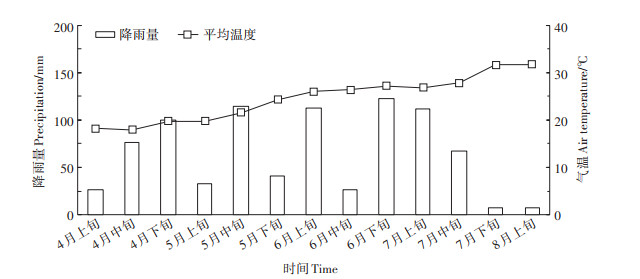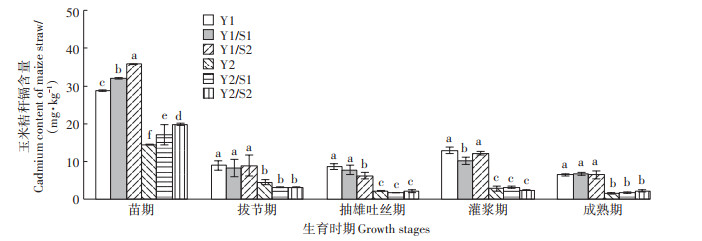2. 中国科学院亚热带农业生态研究所, 长沙 410125
2. Institute of Subtropical Agriculture, Chinese Academy of Sciences, Changsha 410125, China
据报道,中国粮食主产区耕地土壤重金属点位超标率为21.49%,其中重度污染的比例高达5.02%,镉是占比第一的污染物,并且对农业生态系统和人类健康构成了潜在威胁[1-2]。目前,植物修复技术是治理土壤重金属污染的一种绿色经济的新途径,但由于超富集植物生物量小、环境适应能力弱、生长耗时较长,还需要中断农业生产,不符合当前中国耕地资源紧缺的基本国情。因此,寻找最佳的种植结构调整模式,合理利用镉污染农田是当前亟待解决的问题。
间作是我国农业生产中传统的耕作模式,合理的作物间作体系可有效抑制病虫草害发生,促进作物对土壤养分的高效利用,提高作物产量和土地利用率,促进农业生产可持续发展[3-5]。近年来,关于间作控制作物对镉等重金属吸收积累的研究已成为热点之一。李志贤等[6]通过盆栽试验研究了玉米/油菜间作对营养生长期玉米生长和吸收积累镉的影响,结果表明在低、中镉浓度下,间作可以阻控玉米对镉的吸收与积累,但当镉浓度较高时,阻控效应会转为促进作用,增加玉米镉积累量。Vergara等[7]通过盆栽试验研究了大豆/万寿菊间作对铅胁迫下大豆生长的影响,结果表明间作提高了大豆对重金属铅的耐受性,降低了大豆植株铅含量。赵颖等[8]和李凝玉等[9]研究表明豆科植物、黑麦草与玉米间作促进了玉米镉积累,籽粒苋与玉米间作抑制了玉米镉积累。刘海军等[10]试验表明玉米与马唐间作促进了玉米根部镉积累,降低了籽粒镉积累。此外,还有研究表明玉米与豆科作物间作促进了玉米秸秆对微量元素的吸收,降低了籽粒微量元素含量,增强了土壤中有毒物质的降解速率[11-12]。这说明利用间作模式优势在土壤重金属污染区进行种植结构调整具有可行性。
我国西南地区属于亚热带季风气候,光、热、水资源丰富,适宜多熟制农业生产,其中玉米/大豆间作是该区农户广泛采用的种植模式之一[13]。玉米/大豆间作具有充分利用作物物种的互补优势,提高单位面积土地产出量,减少氮肥投入和土壤碳排放等特点[14-15]。玉米和大豆是我国重要的碳水化合物、蛋白质和植物油来源性商品粮作物。然而,有关这两种作物不同品种间镉积累差异的研究多集中于单作条件下,基于玉米/大豆间作体系镉积累差异的研究较少。为此,本研究通过在典型重度镉污染农田建立小区试验,以本课题组前期研究确定的镉积累能力存在显著差异的籽粒高、低镉积累玉米和本栽培区域主栽大豆品种作为对象,对比分析在单作和间作条件下,不同品种玉米和大豆的镉吸收动态、籽粒镉积累量、镉富集系数和产量变化,以期为寻找镉污染农田替代种植模式和风险管控提供科学依据。
1 材料与方法 1.1 供试材料供试玉米品种为前期试验筛选的籽粒相对高镉积累品种登海605和相对低镉积累品种联创808,大豆品种为湖南省主栽品种湘春豆24和湘春豆26。
1.2 试验设计试验于2019年4—8月在湖南省株洲市典型镉污染休耕区试验地(113°08′ 03.8″ E、27°43′ 25.6″ N,海拔35 m)进行,试验期间气温和降雨量变化趋势见图 1,供试土壤理化性质及镉含量见表 1。试验包括单作(大豆单作、玉米单作)和间作(大豆/玉米间作)两种模式,试验处理分别为登海605单作(Y1)、联创808单作(Y2)、湘春豆24单作(S1)、湘春豆26单作(S2)、登海605 /湘春豆24间作(Y1/S1)、联创808 /湘春豆24间作(Y2/S1)、登海605/湘春豆26间作(Y1/ S2)、联创808/湘春豆26间作(Y2/S2),共计8个处理,每个处理3次重复,小区面积30 m2。玉米种植密度为52 500株·hm-2,大豆种植密度为150 000株·hm-2,玉米与大豆间作行比为2:3,间作与单作时种植密度相同。玉米、大豆均于4月6日播种,7月30日收获。玉米施肥用量为氮肥218.25 kg · hm-2,磷肥(P2O5)112.5 kg·hm-2,钾肥(K2O)112.5 kg·hm-2,大豆出苗后施肥用量为氮肥67.5 kg·hm-2,磷肥(P2O5)67.5 kg· hm-2,钾肥(K2O)67.5 kg·hm-2,不施基肥。按照常规方法进行田间管理。

|
图 1 作物生育期气温和降雨量变化 Figure 1 The variation of precipitation and air temperature in 2019 at research station |
|
|
表 1 土壤基本理化性质 Table 1 The basic physical and chemical properties of soil |
分别在大豆幼苗期、现蕾期、结荚期、鼓粒期、成熟期和玉米苗期、拔节期、抽雄吐丝期、灌浆期、成熟期进行植株样品采集,各小区采用五点取样法,每点采集长势一致的玉米3株、大豆6株,采样后混合为一份样品,并于成熟期每小区实收测产,根据实收面积获得的产量折合成单位面积产量,计算实际产量。在室内将样品的秸秆(包括茎秆和叶片)、籽粒烘干至恒质量后,粉碎备用。植株样品经硝酸-高氯酸体系消解后,采用石墨炉原子吸收分光光度法测定植株样品镉含量。

|
式中:Cstraw、Cgrain和Csoil分别表示作物秸秆、籽粒和土壤全镉含量,mg·kg-1;Y1和Y2是单位面积内间作玉米和大豆的产量,kg·hm-2;M1和M2是单位面积内单作玉米和大豆的产量,kg·hm-2。
1.4 数据分析采用Microsoft Excel 2017和SPSS 14.0软件进行数据的整理与分析,差异显著性检验采用Duncan新复极差法和T检验法进行分析。
2 结果与分析 2.1 玉米/大豆间作下玉米秸秆镉含量动态变化间作下玉米不同生育时期秸秆镉含量变化见图 2。在玉米生育期内,随着生育进程的推进间作和单作玉米秸秆镉含量呈现总体降低的变化趋势,玉米苗期秸秆镉含量最高,拔节期到成熟期变化相对平稳,Y1处理玉米各生育时期秸秆镉含量均高于Y2。间作玉米苗期和成熟期秸秆镉含量高于单作;从拔节期到灌浆期,Y1/S1和Y1/S2秸秆的镉含量低于单作,Y2/S1和Y2/S2镉含量变化趋势不同。间作处理苗期秸秆的镉含量较单作显著提高11.61%~37.51%,各处理间差异均达到了显著水平。成熟期Y1/S1、Y2/S1、Y1/S2和Y2/S2处理秸秆镉含量分别较单作提高了4.03%、18.86%、0.14%和46.19%,间作与单作处理间差异不显著。这说明间作促进了玉米苗期和成熟期秸秆镉积累,对玉米拔节期到灌浆期秸秆镉积累的影响因品种及生育时期不同存在差异性。

|
不同字母代表处理间差异显著性(P < 0.05)。下同 Different letters indicate significant difference among treatments at 0.05 level. The same below 图 2 间作下玉米不同生育时期秸秆镉含量变化 Figure 2 The cadmium content in straw of maize at different stages under intercropping |
间作下大豆不同生育时期秸秆镉含量的变化见图 3。随着大豆生育时期的推进,间作和单作大豆秸秆镉含量呈先升高再降低的变化趋势。大豆秸秆镉含量从苗期至结荚期比较平稳,鼓粒期秸秆镉含量显著高于其他生长阶段且差异最大。S1处理苗期秸秆镉含量高于S2,其他生育时期均低于S2。在鼓粒期,单作大豆和间作大豆秸秆镉含量分别为7.109~8.178 mg·kg-1和6.710~12.570 mg·kg-1,除Y1/S1处理低于单作外,其他间作处理均高于单作,其中Y2/S1和Y1/S2与单作差异达到显著水平。在成熟期,Y1/S1和Y2/ S1处理秸秆镉含量分别较单作S1提高1.04%和14.38%,Y1/S2和Y2/S2处理大豆秸秆镉含量分别较单作S2降低19.34%和0.76%,Y2/S1和Y1/S2与单作差异达到显著水平。这说明间作玉米对大豆秸秆镉积累的影响因品种及生育时期而异。

|
图 3 间作下大豆不同生育时期秸秆镉含量变化 Figure 3 The cadmium content in straw of soybean at different stages under intercropping |
由表 2可见,玉米灌浆期籽粒镉含量高于成熟期(P < 0.05),大豆鼓粒期籽粒镉含量低于成熟期(P < 0.05),大豆籽粒镉含量高于玉米(P < 0.05)。间作玉米灌浆期籽粒镉含量较单作降低16.91%~58.14%,除Y2/S1处理外,其他处理与单作差异达到显著水平;成熟期Y1/S1处理较单作显著提高29.75%,Y2/S1和Y2/S2处理分别较单作显著降低88.46%和88.46%,Y1/S2与单作无差异。单作大豆S1籽粒镉含量低于S2,单作玉米Y1籽粒镉含量高于Y2。间作大豆鼓粒期籽粒镉含量除Y1 / S2外,较单作增加5.72%~ 56.46%,Y2/S1处理与单作差异显著;成熟期Y1/S1和Y2/S1较单作显著增加8.94%和10.03%,Y1/S2和Y2/ S2籽粒镉含量较单作降低9.59%和3.08%,Y1/S2与单作差异显著。总的来看,间作降低了玉米灌浆期籽粒镉积累,对玉米成熟期籽粒镉积累的影响因间作大豆品种而异;间作提高了S1籽粒镉积累,对S2籽粒镉积累的影响因间作玉米品种不同存在差异。
|
|
表 2 间作对籽粒镉含量的影响(干质量,mg∙kg-1) Table 2 The effects of intercropping on cadmium concentrations in seeds(dry weight, mg∙kg-1) |
根据《食品安全国家标准食品中污染物限量》(GB 2762—2017),豆类和谷物及其制品镉的限量标准分别为0.2 mg·kg-1和0.1 mg·kg-1。大豆籽粒的镉含量超标3.30~6.57倍,Y1籽粒的镉含量超标21%~ 373%,而Y2除单作处理灌浆期籽粒的镉含量超标29%外,其他籽粒的镉含量均低于国家食品中污染物限量标准,这表明间作降低了低镉积累玉米籽粒的镉含量。
2.4 玉米/大豆间作对作物富集系数和产量的影响由表 3可见,间作提高了玉米秸秆镉富集系数,降低了低镉积累玉米籽粒镉富集系数,大豆镉富集系数的变化因间作玉米品种不同存在差异。大豆和玉米的富集系数均表现为BCFstraw>BCFgrain,大豆BCFstraw和BCFgrain分别为2.567~3.329和0.667~0.764,玉米BCFstraw和BCFgrain分别为0.729~3.339和0.001~0.079。间作玉米BCFstraw较单作增加0.15%~46.23%,差异未达到显著水平。间作低镉积累玉米Y2的BCFgrain较单作显著降低84.62%~92.31%,间作大豆S1的镉富集系数较单作增加2.71%~14.37%。
|
|
表 3 不同处理作物成熟期镉富集系数和产量 Table 3 The cadmium bio-accumulation coefficient of crop maturity and crop yield in different treatments |
玉米和大豆产量为5 526~6 905 kg·hm-2和1 047~ 1 967 kg·hm-2。在玉米与大豆间作体系中,间作大豆产量较单作显著降低33.96%~42.25%,间作玉米产量Y1/S1、Y1/S2和Y2/S2处理分别较单作增加3.64%、12.08%和10.48%,Y2/S1处理较单作降低11.58%,但间作玉米产量与单作无显著性差异。玉米与大豆间作模式的LER为1.46~1.77,这说明间作能提高同等面积土地的使用效率,而且玉米在该间作模式中处于优势地位。
3 讨论不同作物的镉积累能力存在种间和种内差异性。大豆是易吸收积累镉的农作物,而玉米的镉转运能力较弱,大豆富集镉的能力高于玉米[16-18],本研究发现大豆籽粒镉含量高于玉米,大豆鼓粒期籽粒的镉含量低于成熟期,玉米灌浆中期籽粒镉含量高于成熟期,这可能是大豆和玉米镉转运方式的差异性和籽粒发育过程中营养成分的差异造成的[19-20]。不同玉米品种各生育时期秸秆和籽粒镉积累也存在显著性的差异,这与前人研究结果类似[21-22]。不同大豆品种镉积累差异显著[23],而本研究发现不同大豆品种从苗期到鼓粒期秸秆镉含量差异不显著,成熟期秸秆和鼓粒期籽粒镉积累差异显著,这可能与试验选取的大豆品种遗传背景差异较小有关。
不同植物的镉吸收动态变化存在差异性。本研究发现大豆秸秆镉含量呈先升高再降低的变化趋势,玉米秸秆镉含量随着生长时间的增加呈现先降低后逐渐增加再降低的趋势,整体呈现下降的趋势,玉米苗期镉含量最高,从拔节期到成熟期地上部分镉含量相对比较稳定,这与前人报道基本一致[24-26]。本研究还发现大豆鼓粒期镉含量最高,苗期到结荚期镉含量相对比较稳定,这可能与大豆的根系特性密切相关,苗期根系活力较弱,吸收的镉大部分集中在根部,随着大豆植株的生长,根系吸收和木质部转运镉能力增强,地上部分营养物质需求增加,进而导致大豆秸秆镉含量逐渐增加。
间作对植物镉积累的影响存在差异性。有研究表明镉超富集植物与农作物间作可提高超富集植物镉积累量,抑制农作物镉积累[27-29],不同农作物间作也可以降低作物的镉积累[30-31]。本研究结果表明间作提高了玉米成熟期秸秆镉含量,降低了低镉积累玉米籽粒镉含量,对大豆镉积累的影响因品种不同而异,初步推测可能有两个原因,一是间作改变了根系及根际土壤酶活性和微生物群落结构,影响了不同品种大豆根系的细胞壁区隔化特性和玉米植株体内重金属元素转运量的变化,从而形成了间作效应差异性;二是间作玉米的根系寿命更长,所占空间更大,这可能有助于间作玉米地上部吸收较多的镉[32-34]。
间作降低了作物食用部分镉积累量,玉米间作是进行重金属污染土壤植物修复并实现农业安全生产的有效途径之一[35-37]。本研究发现成熟期低镉积累玉米籽粒镉含量低于《食品安全国家标准食品中污染物限量》(GB 2762—2017),间作降低了其籽粒镉含量。大豆籽粒镉含量超过国家食品污染物限量标准,但通过加工生产食用油,大豆油镉含量仅为籽粒的0.3%[38],后期应进一步加强研究豆粕中镉的脱除技术。玉米和大豆BCFstraw均大于BCFgrain,说明作物秸秆富集镉的能力强,后期可将作物秸秆进行无害化处理后进行应用[1]。此外,本研究还发现间作处理LER均大于1,这与前人研究结果一致[39]。由此可见,间作可以有效利用土地资源,有利于保证重度镉污染地区低镉积累玉米可食用部分的安全生产,但该间作模式不能作为重度镉污染农田种植结构调整替代模式,该模式能否用于中、轻度镉污染农田种植结构调整还需进一步验证。
4 结论随着生育期变化,玉米秸秆镉含量总体呈下降趋势,大豆秸秆镉含量呈逐渐升高再降低的趋势,大豆鼓粒期籽粒镉含量小于成熟期,玉米灌浆中期籽粒镉含量高于成熟期。
间作提高了玉米秸秆镉富集系数,高镉积累和低镉积累玉米成熟期籽粒镉含量单作分别为0.121 mg· kg-1和0.026 mg·kg-1,间作平均分别为0.139 mg·kg-1和0.003 mg·kg-1,间作低镉积累玉米籽粒镉含量较单作平均降低了88.46%。玉米/大豆间作的LER均大于1。因此,间作有利于保证镉污染地区低镉积累玉米可食用部分的安全生产,可以合理利用耕地资源,但不能作为重度镉污染农田替代种植模式。
| [1] |
Mohamed I, Ali M, Ahmed N, et al. Cadmium immobilization and alleviation of its toxicity for soybean grown in a clay loam contaminated soil using sugarcane bagasse-derived biochar[J]. Environmental Science and Pollution Research, 2019, 26(21): 21849-21857. DOI:10.1007/s11356-019-05501-7 |
| [2] |
尚二萍, 许尔琪, 张红旗, 等. 中国粮食主产区耕地土壤重金属时空变化与污染源分析[J]. 环境科学, 2018, 39(10): 4670-4683. SHANG Er-ping, XU Er-qi, ZHANG Hong-qi, et al. Spatial-temporal trends and pollution source analysis for heavy metal contamination of cultivated soils in five major grain producing regions of China[J]. Environment Science, 2018, 39(10): 4670-4683. |
| [3] |
Martin-Guay M O, Paquette A, Dupras J, et al. The new green revolution:Sustainable intensification of agriculture by intercropping[J]. Science of the Total Environment, 2018, 615: 767-772. DOI:10.1016/j.scitotenv.2017.10.024 |
| [4] |
Luo S, Yu L, Liu Y, et al. Effects of reduced nitrogen input on productivity and N2O emissions in a sugarcane/soybean intercropping system[J]. European Journal of Agronomy, 2016, 81: 78-85. DOI:10.1016/j.eja.2016.09.002 |
| [5] |
Hong Y, Heerink N, Jin S, et al. Intercropping and agroforestry in China:Current state and trends[J]. Agriculture, Ecosystems and Environment, 2017, 244: 52-61. DOI:10.1016/j.agee.2017.04.019 |
| [6] |
李志贤, 陈章, 陈国梁, 等. 镉富集植物油菜与玉米间作对玉米吸收积累镉的影响[J]. 生态学杂志, 2016, 35(1): 26-31. LI Zhi-xian, CHEN Zhang, CHEN Guo-liang, et al. Effects of maizerape intercropping on Cd uptake and accumulation by maize[J]. Chinese Journal of Ecology, 2016, 35(1): 26-31. |
| [7] |
Vergara Cid C, Pignata M L, Rodriguez J H. Effects of co-cropping on soybean growth and stress response in lead-polluted soils[J]. Chemosphere, 2020, 246: 125833. DOI:10.1016/j.chemosphere.2020.125833 |
| [8] |
赵颖, 刘利军, 党晋华, 等. 不同植物与玉米间作对玉米吸收多环芳烃和重金属的影响[J]. 环境工程, 2014, 32(7): 138-141. ZHAO Ying, LIU Li-jun, DANG Jin-hua, et al. Effects of intercropping different crops with maize on its uptake of the PAHs and heavy metal[J]. Environmental Engineering, 2014, 32(7): 138-141. |
| [9] |
李凝玉, 李志安, 丁永祯, 等. 不同作物与玉米间作对玉米吸收积累镉的影响[J]. 应用生态学报, 2008, 19(6): 1369-1373. LI Ning-yu, LI Zhi-an, DING Yong-zhen, et al. Effects of intercropping different crops with maize on the Cd uptake by maize[J]. Chinese Journal of Applied Ecology, 2008, 19(6): 1369-1373. |
| [10] |
刘海军, 陈源泉, 隋鹏, 等. 马唐与玉米间作对镉的富集效果研究初探[J]. 中国农学通报, 2009, 25(15): 206-210. LIU Hai-jun, CHEN Yuan-quan, SUI Peng, et al. The uptake and accumulation effect of Cd In the maize-crabgrass intercropping system[J]. Chinese Agricultural Science Bulletin, 2009, 25(15): 206-210. |
| [11] |
Li H, Liu L, Lin C, et al. Plant uptake and in-soil degradation of PCB-5 under varying cropping conditions[J]. Chemosphere, 2011, 84(7): 943-949. DOI:10.1016/j.chemosphere.2011.06.007 |
| [12] |
Fu Z D, Zhou L, Chen P, et al. Effects of maize-soybean relay intercropping on crop nutrient uptake and soil bacterial community[J]. Journal of Integrative Agriculture, 2019, 18(9): 2006-2018. DOI:10.1016/S2095-3119(18)62114-8 |
| [13] |
Khan K, Rajesh Kumar V. Diversifying cropping systems with aromatic crops for better productivity and profitability in subtropical north Indian plains[J]. Industrial Crops and Products, 2018, 115: 104-110. DOI:10.1016/j.indcrop.2018.02.004 |
| [14] |
Chen P, Song C, Liu X M, et al. Yield advantage and nitrogen fate in an additive maize-soybean relay intercropping system[J]. Science of the Total Environment, 2019, 657: 987-999. DOI:10.1016/j.scitotenv.2018.11.376 |
| [15] |
Xu Z, Li C, Zhang C, et al. Intercropping maize and soybean increases efficiency of land and fertilizer nitrogen use:A meta-analysis[J]. Field Crops Research, 2020, 246: 107661. DOI:10.1016/j.fcr.2019.107661 |
| [16] |
Zhao Y, Fang X, Mu Y, et al. Metal pollution(Cd, Pb, Zn, and As)in agricultural soils and soybean, glycine max, in Southern China[J]. Bulletin of Environmental Contamination and Toxicology, 2014, 92(4): 427-432. DOI:10.1007/s00128-014-1218-5 |
| [17] |
Zhuang P, Li Z A, Zou B, et al. Heavy metal contamination in soil and soybean near the Dabaoshan mine, South China[J]. Pedosphere, 2013, 23(3): 298-304. DOI:10.1016/S1002-0160(13)60019-3 |
| [18] |
魏祥东, 邹慧玲, 铁柏清, 等. 种植模式对南方旱地重金属含量及其迁移规律的影响[J]. 农业环境科学学报, 2015, 34(6): 1096-1106. WEI Xiang-dong, ZOU Hui-ling, TIE Bai-qing, et al. Effects of different planting patterns on concentrations and migration of soil heavy metals in dryland in southern China[J]. Journal of Agro-Environment Science, 2015, 34(6): 1096-1106. |
| [19] |
Nakanishi T M. 109Cd uptake and translocation in a soybean plant under different pH conditions[J]. Journal of Radioanalytical and Nuclear Chemistry, 2005, 264(2): 303-306. DOI:10.1007/s10967-005-0711-z |
| [20] |
Sugiyama M, Ae N, Arao T. Role of roots in differences in seed cadmium concentration among soybean cultivars-proof by grafting experiment[J]. Plant and Soil, 2007, 295(1): 1-11. |
| [21] |
辛艳卫, 梁成华, 杜立宇, 等. 不同玉米品种对镉的富集和转运特性[J]. 农业环境科学学报, 2017, 36(5): 839-846. XIN Yan-wei, LIANG Cheng-hua, DU Li-yu, et al. Accumulation and translocation of cadmium in different maize cultivars[J]. Journal of Agro-Environment Science, 2017, 36(5): 839-846. |
| [22] |
王艳芳, 悦飞雪, 李冬, 等. 镉胁迫对不同基因型玉米生长和镉吸收分配的影响[J]. 核农学报, 2019, 33(7): 1440-1447. WANG Yan-fang, YUE Fei-xue, LI Dong, et al. Effects of cadmium stress on plant growth, cadmium absorption and distribution of different genotypes of maize[J]. Journal of Nuclear Agricultural Sciences, 2019, 33(7): 1440-1447. |
| [23] |
赵云云, 钟彩霞, 方小龙, 等. 华南地区夏播大豆品种镉耐性及籽粒镉积累的差异[J]. 大豆科学, 2013, 32(3): 336-340. ZHAO Yun-yun, ZHONG Cai-xia, FANG Xiao-long, et al. Genotypic differences in tolerance and accumulation to Cd among summer-sowing soybean varieties in south China[J]. Soybean Science, 2013, 32(3): 336-340. |
| [24] |
王朋, 邓小娟, 黄益安, 等. 镉胁迫下不同大豆品种各器官中镉和非蛋白巯基物质的动态变化[J]. 华南农业大学学报, 2016, 37(2): 42-50. WANG Peng, DENG Xiao-juan, HUANG Yi-an, et al. Dynamic changes of cadmium and non-protein thiol in different organs of different soybean genotypes under cadmium stress[J]. Journal of South China Agricultural University, 2016, 37(2): 42-50. |
| [25] |
殷志遥, 和君强, 秦华, 等. 覆膜对伴矿景天生长和吸镉动态影响研究[J]. 农业环境科学学报, 2019, 38(5): 1043-1050. YIN Zhi-yao, HE Jun-qiang, QIN Hua, et al. Effect of film mulchingon plant growth and cadmium uptake by Sedum plumbizincicola[J]. Journal of Agro-Environment Science, 2019, 38(5): 1043-1050. |
| [26] |
郑海飘, 敖和军, 杜志艳, 等. 不同类型高粱对重金属镉吸收积累的动态变化[J]. 分子植物育种, 2018, 16(19): 6481-6487. ZHENG Hai-piao, AO He-jun, DU Zhi-yan, et al. Dynamic changes of cadmium absorption and accumulation in different types of sorghum[J]. Molecular Plant Breeding, 2018, 16(19): 6481-6487. |
| [27] |
谭建波, 陈兴, 郭先华, 等. 续断菊与玉米间作系统不同植物部位Cd、Pb分配特征[J]. 生态环境学报, 2015, 24(4): 700-707. TAN Jian-bo, CHEN Xing, GUO Xian-hua, et al. Distribution characteristics of Pb and Cd in different parts of Sonchus asper and Zea mays in an intercropping system[J]. Ecology and Environmental Sciences, 2015, 24(4): 700-707. |
| [28] |
王效国.大豆、龙葵单作和间作对镉、芘污染土壤的修复[D].杨凌: 西北农林科技大学, 2015: 14-16. WANG Xiao-guo. Remediation of cadmium and pyrene contamionated soil by monoculture and intercropping of Glycine max and Solanum nigrum[D]. Yangling: Northwest A & F University, 2015: 14-16. http://cdmd.cnki.com.cn/Article/CDMD-10712-1015329791.htm |
| [29] |
霍文敏, 赵中秋, 王丽, 等. 不同超富集、富集植物-玉米间作模式对玉米中镉吸收、转运的影响研究[J]. 地学前缘, 2019, 26(6): 118-127. HUO Wen-min, ZHAO Zhong-qiu, WANG Li, et al. Study of the effects of intercropping different hyperaccumulator and accumulator plants on Cd uptake and transportation by maize[J]. Earth Sciences Frontiers, 2019, 26(6): 118-127. |
| [30] |
王吉秀, 祖艳群, 李元, 等. 玉米和不同蔬菜间套模式对重金属Pb、Cu、Cd累积的影响研究[J]. 农业环境科学学报, 2011, 30(11): 2168-2173. WANG Ji-xiu, ZU Yan-qun, LI Yuan, et al. Effects of maize and vegetable intercropping system on accumulation of Pb, Cu and Cd in plants[J]. Journal of Agro-Environment Science, 2011, 30(11): 2168-2173. |
| [31] |
Su D C, Lu X X, Wong J W C. Could cocropping or successive cropping with Cd accumulator oilseed rape reduce Cd uptake of sensitive Chinese cabbage?[J]. Practice Periodical of Hazardous, Toxic, and Radioactive Waste Management, 2008, 12(3): 224-228. DOI:10.1061/(ASCE)1090-025X(2008)12:3(224) |
| [32] |
Li L, Li S M, Sun J H, et al. Diversity enhances agricultural productivity via rhizosphere phosphorus facilitation on phosphorus-deficient soils[J]. Proceedings of the National Academy of Sciences, 2007, 104(27): 11192. DOI:10.1073/pnas.0704591104 |
| [33] |
Li L, Sun J, Zhang F. Intercropping with wheat leads to greater root weight density and larger below-ground space of irrigated maize at late growth stages[J]. Soil Science and Plant Nutrition, 2011, 57(1): 61-67. DOI:10.1080/00380768.2010.548307 |
| [34] |
Wang P, Yang B, Wan H, et al. The differences of cell wall in roots between two contrasting soybean cultivars exposed to cadmium at young seedlings[J]. Environmental Science and Pollution Research, 2018, 25(29): 29705-29714. DOI:10.1007/s11356-018-2956-4 |
| [35] |
谭建波, 湛方栋, 刘宁宁, 等. 续断菊与蚕豆间作下土壤部分化学特征与Cd形态分布状况研究[J]. 农业环境科学学报, 2016, 35(1): 53-60. TAN Jian-bo, ZHAN Fang-dong, LIU Ning-ning, et al. Soil chemical properties and Cd form distribution in Vicia faba and Sonchus asper intercropping system[J]. Journal of Agro-Environment Science, 2016, 35(1): 53-60. |
| [36] |
王京文, 蔡梅, 郑洁敏, 等. 丝瓜与伴矿景天间作对土壤Cd形态及丝瓜Cd吸收的影响[J]. 农业环境科学学报, 2016, 35(12): 2292-2298. WANG Jing-wen, CAI Mei, ZHENG Jie-min, et al. Investigating the intercropping effects of Sedum plumbizincicola and Luffa cylindrical on soil cadmium fractions and cadmium uptake by Luffa cylindrical[J]. Journal of Agro-Environment Science, 2016, 35(12): 2292-2298. |
| [37] |
An L Y, Pan Y H, Wang Z B, et al. Heavy metal absorption status of five plant species in monoculture and intercropping[J]. Plant and Soil, 2011, 345(1/2): 237-245. |
| [38] |
何勇强, 陶勤南, 小畑仁, 等. 镉胁迫下大豆中镉的分布状况及其籽粒品质[J]. 环境科学学报, 2000, 20(4): 510-512. HE Yong-qiang, TAO Qin-nan, Obata H, et al. Distribution of cadmium in soybean and quality of soybean seed under cadmium stress[J]. Acta Scientiae Circumstantiae, 2000, 20(4): 510-512. |
| [39] |
Song C, Wang Q, Zhang X, et al. Crop productivity and nutrients recovery in maize-soybean additive relay intercropping systems under subtropical regions in Southwest China[J]. International Journal of Plant Production, 2020, 14: 373-387. DOI:10.1007/s42106-020-00090-9 |
 2020, Vol. 39
2020, Vol. 39





